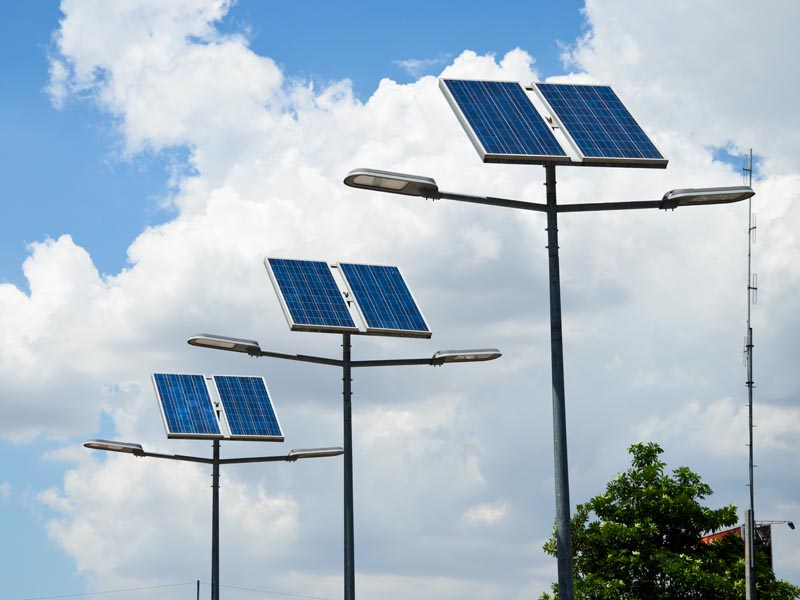Street lighting is essential for cities, communities, and even private properties, enhancing safety, visibility, and ambiance in outdoor areas. As more sustainable energy options become available, the debate between solar street lights and traditional street lights is intensifying. With advancements in solar technology, many are reconsidering the benefits of traditional electric-powered street lights versus those powered by renewable solar energy. In this article, let’s dive into the key differences between these two lighting solutions and explore why solar street lights might be the preferred choice for the future.
What Are Solar Street Lights?
Solar street lights are an innovative lighting solution that harnesses the energy of the sun, transforming it into electricity. Unlike traditional lights that rely on the electrical grid, solar street lights operate independently. Each unit generally comprises solar panels that capture sunlight, batteries that store energy for nighttime use, LED lamps that efficiently illuminate the area, and a controller to regulate the system. In sunny regions like Dubai, solar street lights have become a reliable, sustainable option for outdoor lighting.
How Do Ordinary Street Lights Work?
Ordinary street lights, or traditional street lights, are connected to the power grid and usually use high-intensity discharge (HID) lamps or LEDs. These lights draw energy directly from the grid, which often relies on non-renewable sources like coal and natural gas. Installing these lights requires extensive wiring and underground connections, leading to higher installation costs and more complicated infrastructure requirements.
Energy Source Differences: Renewable vs. Non-Renewable
One of the most significant distinctions between solar and ordinary street lights is their energy source. Solar street lights depend on renewable energy, which makes them eco-friendly and reduces reliance on fossil fuels. Traditional street lights, however, pull power from the grid, which still largely depends on non-renewable energy sources. This reliance on fossil fuels not only drives up energy costs but also increases the environmental impact.
Environmental Impact of Solar Street Lights
The environmental benefits of solar street lights cannot be overstated. By choosing solar street lights, you significantly reduce the environmental footprint of outdoor lighting systems. Solar energy is clean and renewable, meaning it doesn’t produce greenhouse gas emissions or air pollutants during operation. Installing solar-powered lights is an excellent step toward lowering carbon emissions, particularly in urban areas aiming to improve sustainability. Conversely, traditional street lights contribute to carbon emissions because they rely on the grid, which is often powered by fossil fuels that pollute the environment.
Ease of Installation
The ease of installation is another area where solar street lights stand out. Installing solar lights is relatively straightforward since they don’t require a connection to the electrical grid. There’s no need for complex wiring or underground connections, which significantly speeds up the installation process and lowers costs. This independence from the grid also makes solar street lights ideal for remote or rural areas where infrastructure is limited. Ordinary street lights, on the other hand, require extensive wiring, specialized equipment, and, in some cases, road closures to complete the setup, making the process more time-consuming and costly.
Maintenance Requirements
Solar street lights are generally low-maintenance. They primarily require occasional battery checks and periodic cleaning of the solar panels to maintain efficiency. Traditional street lights, however, often need more frequent maintenance, such as bulb replacements, electrical repairs, and wiring checks. This maintenance can be particularly challenging and costly in regions with harsh weather conditions or high rates of vandalism. Thus, when it comes to maintenance, solar street lights tend to be a more practical choice.
Cost Comparison: Upfront Costs vs. Long-Term Savings
Cost is often a critical factor in deciding between solar and traditional street lights. While solar street lights usually require a higher initial investment, they offer significant savings over time. With no ongoing electricity bills and lower maintenance costs, solar street lights often pay for themselves over the years. Traditional street lights, though less expensive upfront, tend to incur higher costs in the long run due to regular energy bills and maintenance. For city planners or property managers who are budgeting with a long-term perspective, solar street lights represent a smart financial decision.
Energy Efficiency of Solar Street Lights
Solar street lights are inherently more energy-efficient than their traditional counterparts. These lights utilize the abundant, free energy provided by the sun and convert it into light without relying on fossil fuels. The conversion is highly efficient, especially with advancements in LED and battery technology. Traditional street lights, however, require continuous energy from the grid, leading to ongoing energy costs and a greater environmental impact. For those looking to reduce their carbon footprint and energy expenses, solar lighting provides a more sustainable solution.
Reliability During Power Outages
Reliability is a key factor when comparing lighting options, especially in areas prone to power disruptions. One of the distinct advantages of solar street lights is their resilience during power outages. Because they are independent of the electrical grid, solar street lights continue to function even if there is a blackout, providing essential lighting during emergencies. Ordinary street lights, however, are directly affected by power outages, leaving streets and public spaces in darkness when the grid fails. This resilience makes solar street lights a reliable choice for areas that need continuous lighting.
Durability and Lifespan
Solar street lights are built for durability and have a long lifespan. The LED lights used in solar systems are energy-efficient and can last up to 20 years, depending on the model and quality of the components. Additionally, the minimal wear on parts, like batteries and LEDs, reduces the need for frequent replacements. Traditional street lights, particularly those that use HID lamps, tend to have a shorter lifespan, requiring replacements every few years. Solar street lights, therefore, offer a cost-effective and long-lasting solution for outdoor lighting.
Quality of Light and Consistency
Light quality is another factor where solar street lights excel. Solar lights typically use LEDs, which offer consistent brightness, high color accuracy, and efficiency. LEDs are known for maintaining high-quality light output throughout their lifespan, providing excellent visibility and safety. Traditional street lights, especially older ones that use HID lamps, may experience fluctuations in brightness and color over time, which can affect visibility. For areas requiring reliable and high-quality lighting, solar-powered LED lights are often the superior choice.
Versatility for Remote and Off-Grid Locations
One of the unique advantages of solar street lights is their versatility in remote or off-grid locations. Since they don’t need to be connected to the electrical grid, they can be installed in rural or remote areas, providing much-needed lighting to communities that would otherwise be in the dark. This adaptability makes solar street lights an ideal solution for developing regions and rural areas with limited access to electrical infrastructure. In contrast, ordinary street lights are limited by their dependence on the power grid, making them less feasible in off-grid locations.
Advancements in Solar Street Light Technology
With advancements in technology, solar street lights have become more efficient and user-friendly. Many modern solar lights now come with smart features, such as motion sensors, dimming capabilities, and even remote monitoring systems. These features help optimize performance, extend battery life, and reduce energy consumption, offering a more customizable and energy-efficient lighting solution. Although some traditional street lights may also have smart features, solar lights benefit from integrating these technologies without increasing energy costs.
Smart Control and Automation
Solar street lights have also integrated intelligent control systems, allowing for more efficient and customizable operation. Many modern solar lights feature automation options, enabling them to adjust brightness based on ambient light or specific times of the day. Additionally, some systems allow for remote monitoring and control via smartphone apps, making it easy to manage lighting across large areas. Traditional street lights may lack such flexibility, as they depend on centralized grid control, which can be limited in terms of customization and energy management.
Battery Life and Storage Capacity
The battery life of solar street lights has also seen significant improvements. Newer models use advanced lithium-ion or lithium phosphate batteries, which have higher storage capacity and longer lifespans. These batteries are designed to last for several years, reducing the need for frequent replacements. Traditional street lights, in contrast, don’t require batteries but are entirely dependent on the power grid, which can limit their utility during outages or periods of reduced electricity availability.
Solar Street Lights in Dubai: A Sustainable Solution
Dubai is one of the cities that stands to benefit immensely from solar street lights due to its abundant sunlight and commitment to sustainability. Solar street lights in Dubai offer a sustainable and cost-effective solution for public lighting, aligning with the city’s environmental goals of reducing carbon emissions and promoting green energy. Various solar EPC companies in Dubai are actively contributing to this transition, helping the city lead by example in sustainable urban infrastructure.
How to Choose the Right Solar Street Light
If you’re considering making the switch to solar street lights, especially in sunny regions like Dubai, there are a few key aspects to consider. Look for high-quality materials, adequate battery capacity, and reputable suppliers when buying solar outdoor lights online. Since solar lights come in various designs and specifications, it’s essential to select a model that meets your specific needs and can withstand local climate conditions. Consulting with a solar EPC company in Dubai can also help ensure you choose the right system for your requirements.
Future of Outdoor Lighting
The future of outdoor lighting seems to be leaning heavily toward solar power. With the pressing need for sustainable solutions, cities and countries worldwide are shifting towards solar street lights as part of their green initiatives. As technology continues to improve, we can expect even more efficient, durable, and affordable solar lighting solutions to become available, making it easier for communities to embrace renewable energy for their lighting needs.
Conclusion
When comparing solar street lights and ordinary street lights, it becomes clear that solar lights offer a more sustainable, cost-effective, and reliable solution. Although they may come with a higher upfront cost, the long-term savings, environmental benefits, and increased resilience to power outages make them a worthy investment. By choosing solar street lights, cities and communities can enjoy safer, brighter outdoor spaces while supporting environmental conservation efforts. Whether you’re in Dubai or any other region with ample sunlight, solar street lights provide a smart, sustainable choice for modern outdoor lighting.
For an energy-efficient, environmentally friendly, and cost-effective solution, it’s time to make the switch to solar. The benefits far outweigh the costs, offering a cleaner, greener, and brighter future.




